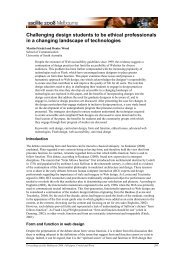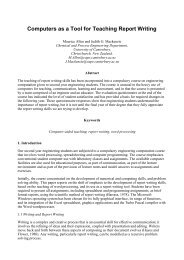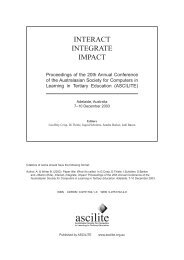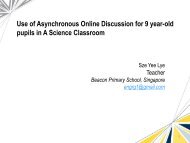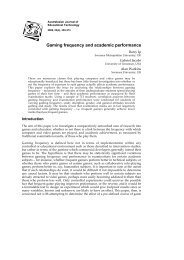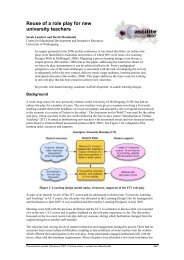Authentic assessment strategies in problem based learning - ascilite
Authentic assessment strategies in problem based learning - ascilite
Authentic assessment strategies in problem based learning - ascilite
You also want an ePaper? Increase the reach of your titles
YUMPU automatically turns print PDFs into web optimized ePapers that Google loves.
Conclusion<br />
Figure 13: Project snapshot for T11<br />
These authentic <strong>assessment</strong> <strong>strategies</strong> were <strong>in</strong>stilled to promote a more student-centred approach to<br />
<strong>problem</strong> <strong>based</strong> learn<strong>in</strong>g. Students played a larger role <strong>in</strong> learn<strong>in</strong>g where each of them was responsible for<br />
their own learn<strong>in</strong>g. In this PBL sett<strong>in</strong>g, students constructed and shared knowledge between peers,<br />
<strong>in</strong>volved <strong>in</strong> active learn<strong>in</strong>g and went through various form of knowledge evaluation techniques.<br />
Meanwhile, <strong>in</strong>structors played the role of the facilitator, prob<strong>in</strong>g and guid<strong>in</strong>g students to group processes<br />
and also additional resources.<br />
The authentic <strong>assessment</strong> <strong>strategies</strong> have shown to benefit the students. Through these <strong>assessment</strong>s,<br />
students’ <strong>problem</strong> solv<strong>in</strong>g skills related to real-world issues and high-level understand<strong>in</strong>g were assessed<br />
and evaluated. As shown <strong>in</strong> the results, although some teams were unable to achieve the learn<strong>in</strong>g<br />
outcome, through authentic <strong>assessment</strong>s, students’ became aware of their mistakes especially <strong>in</strong> areas of<br />
communication and knowledge shar<strong>in</strong>g, and so learnt not to repeat the mistake <strong>in</strong> the future.<br />
Process asessment which conta<strong>in</strong>s of Self Reflection, Peer’s Evaluation and Task Completion Reports<br />
allowed the students <strong>in</strong> identify<strong>in</strong>g one's own progress and deficiencies, mak<strong>in</strong>g them <strong>in</strong>dependent<br />
learners. Content <strong>assessment</strong> served as a measur<strong>in</strong>g tool to evaluate students’ knowledge ga<strong>in</strong>, together<br />
with the ability to understand and apply knowledge learned from this PBL sett<strong>in</strong>g. And lastly, portfolio<br />
<strong>assessment</strong> enabled students to not only see the f<strong>in</strong>al learn<strong>in</strong>g outcome but to track their learn<strong>in</strong>g progress,<br />
achievement and growth with the documentation done <strong>in</strong> various forms.<br />
All <strong>in</strong> all, implementation of authentic <strong>assessment</strong> <strong>strategies</strong> is seen as a tedious process to evaluate<br />
students’ learn<strong>in</strong>g, a more efficient authentic <strong>assessment</strong> strategy is needed to maximize future research <strong>in</strong><br />
PBL.<br />
References<br />
Aspy, D.N., Aspy, C. B., & Quimby, P.M. (1993). What doctors can teach teachers about <strong>problem</strong>-<strong>based</strong><br />
learn<strong>in</strong>g. Educational Leadership, 50(7), 22-24.<br />
Bridges, E. M., & Hall<strong>in</strong>ger, P. (1991,). Problem-<strong>based</strong> learn<strong>in</strong>g <strong>in</strong> medical and managerial education.<br />
Paper presented for the Cognition and School Leadership Conference of the National Centre for<br />
Educational Leadership and the Ontario Institute for Studies <strong>in</strong> Education, Nashville, TN.<br />
George, J. & Cowan, J. (1999). A Handbook of Techniques for Formative Evaluation (1 st Ed.). London:<br />
Kogan Page Limited.<br />
Glasgow, N. A. (1996). New curriculum for new times: A guide to student-cantered, <strong>problem</strong>-<strong>based</strong><br />
learn<strong>in</strong>g, Thousand Oaks. CA: Corw<strong>in</strong> Press.<br />
Hart, D. (1994). <strong>Authentic</strong> Assessment: A Handbook for Educators. Menlo Park, CA; Addison-Wesley<br />
Pub. Co.<br />
Herr<strong>in</strong>gton, J., & Herr<strong>in</strong>gton, A. (1998). <strong>Authentic</strong> <strong>assessment</strong> and multimedia: How university students<br />
respond to a model of authentic <strong>assessment</strong>. Higher Education Research and Development, 17 (3),<br />
305-22.<br />
Moursund, D.G. (1999). Project-<strong>based</strong> learn<strong>in</strong>g us<strong>in</strong>g <strong>in</strong>formation technology. Eugene, OR: ISTE.<br />
Neo. T. K. (2003). Us<strong>in</strong>g multimedia <strong>in</strong> a constructivist learn<strong>in</strong>g environment <strong>in</strong> the Malaysian classroom.<br />
Australian Journal of Educational Technology 19(3), 293-310.<br />
http://www.<strong>ascilite</strong>.org.au/ajet/ajet19/neo.html<br />
Proceed<strong>in</strong>gs <strong>ascilite</strong> S<strong>in</strong>gapore 2007: Full paper: Tai and Yuen 992



